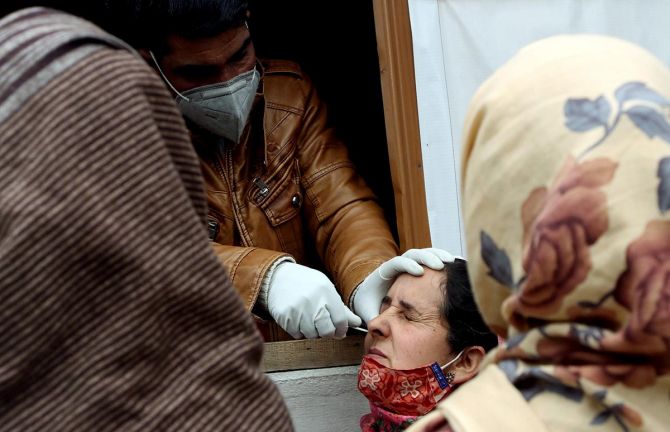The data gaps are inhibiting sound decisions.
We need to know seroprevalence, infection, and vaccination rates.
This is required in 200 cities of India, every week, suggests Ajay Shah.

Through 2020, it felt like the epidemic was gradually subsiding. We now have a second wave of COVID-19 on our hands.
This appears to reflect a combination of new variants, reduced social distancing, and difficulties of the data.
Lockdowns are a blunt instrument and should be avoided.
Firms need to strategise for 2021 and 2022 in this modified reality. The most important levers are better data and ending State control of vaccination.
The disease spread rapidly in early 2020. By July/August, seroprevalence studies were showing that a substantial proportion of India had developed antibodies.
Evidence in Mumbai suggested that the rich had been able to hide in their homes while the poor had developed immunity.
There was a tantalising prospect that from here, the rich would jump to vaccination and the story would subside.
But in the tug of war between vaccines, variants, and behaviour, we may have a second wave.
The standard data on the number of tests and positives is problematic. The event of testing is a non-random one.
Last year, for some months, the government monopolised testing, and only opened up to private testing with a lag. There was shortages of tests.
The epidemic was raging in the poor, and they often don't test.
Hence, the testing data last year missed out on a lot of sickness, as is seen in the mismatch between the testing data and the seroprevalence data.
Today, the disease is spreading in the rich, who are more likely to get tested.
Capacity constraints have been removed through private testing.
We hear reports of stress in healthcare system capacity, which is also consistent with the fact that the rich are more likely to seek healthcare.
Non-random testing has been the bane of the conventional Covid-19 data in India, and the present situation is a nice example of why this data should be approached with caution.
The only useful data on COVID-19 in India is that obtained from random samples of households.

An important new variant has come up. Named B.1.1.7, it is more infectious and more virulent.
Other variants such as E484K are a daunting prospect.
There is a reasonable possibility that new variants are afoot in India.
By this reasoning, COVID-19 today is a harder problem than it was last year.
The vaccines widely used worldwide are generally effective against new variants.
But scientists will have to roll out modified vaccines to keep up with the variants, and regular booster shots will likely be required to load new data into the human immune system.
People are emotionally stressed from long months of social distancing, and there is economic stress too.
The revival of the US economy has helped trigger global improvements in economic conditions, and everyone is anxious to harness every business opportunity in order to restore income.
This has come at a certain amount of sacrifice of precautions.
In this situation, what should decision makers do?
Firms should consider it possible that governments will impose additional lockdowns. It would be wise to reflect on how the last experience with lockdowns worked out, and find ways to fare better in such scenarios in the future.
Firms should expect that the economic stress associated with COVID-19 will not end soon; it will cast a shadow over 2021-2022.
Remote work was not just an aberration, it will be a sustained part of the modern workplace, and processes need to be modified for that environment.
Every effort should be made by firms to run vaccination campaigns targeting employees, customers, and their family members as this is the true path to normalisation.
Remote work, adult vaccination campaigns, and temperature screening at the door are the new steady state.
For decision makers in government, muscular lockdowns are security theatre but fare poorly in cost-benefit analysis.
The testing data overstates the second wave. It is always better to coerce less, and to push gentle public health tools such as masks.
State power should be used in limited ways -- to block weddings, temples, and nightclubs, and to force changes in ventilation with air conditioners.
We need to do better on vaccination. At present, 5 per cent of India has some vaccine vs 50 per cent in the UK.
On a flow basis, the US and the UK are pushing out about 0.8 to 0.9 doses per 100 people per day, while India is at the value of 0.15, ie, six times worse.

Consider an analogy. When COVID-19 testing in India began, State power was used to prevent private labs from testing. This worked poorly.
In time, saner voices prevailed, and the vast capacity of the Indian private healthcare system was harnessed into testing. As a result, India's testing gap was closed.
The State system is currently monopolising vaccination. State-led vaccination is working well in the US and the UK.
In India, State capacity is low, and the flow of doses is six times inferior.
Policymakers should remove all State coercion in vaccination.
We need a torrent of energy in India -- importing multiple vaccines and organising vaccination camps for neighbours, employees, customers, campuses, etc.
For example, in most of India, the imported one-dose J&J vaccine is highly attractive, given the operational problems of two doses.
We should avoid a vaccine monoculture, as this will be more vulnerable to one particular variant which figures out how to evade this.
At the present run rate of 3 million doses a day, we will get to 1 billion people vaccinated in about 600 days.
If we are able to achieve half of the UK/US rates (to 0.5 doses per 100 people per day), this will come down to 190 days.
The data gaps are inhibiting sound decisions.
We need to know seroprevalence, infection, and vaccination rates.
We need genomic surveillance of variants, and track reinfection rates for each vaccine.
This is required in 200 cities of India, every week, through a random sample of households.
Ajay Shah is an independent scholar.
Feature Presentation: Rajesh Alva/Rediff.com











